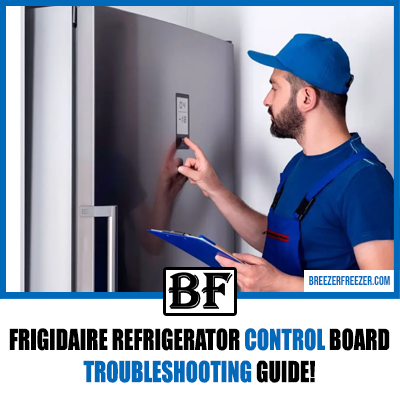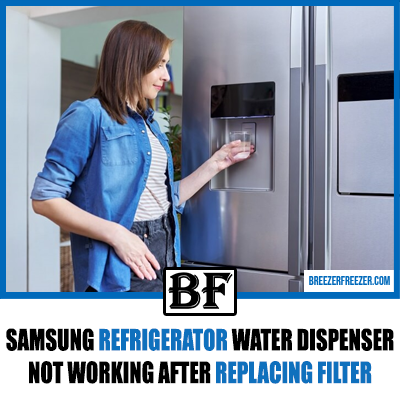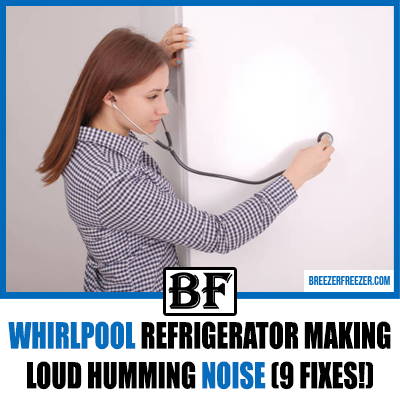GE Profile Refrigerator Not Cooling But Freezer Is Fine? (Solved!)
Is your GE Profile refrigerator not cooling properly while the freezer remains cold? This is an unusual occurrence that indicates a problem.

Several factors can contribute to this issue, including overstocking or understocking, dirt-clogged condenser coils, frozen evaporator coils, a loose door gasket, a broken Start Relay, or faulty components such as the thermistor, evaporator fan motor, damper defrost, or control board.
In this article, we will explore these potential causes in detail and provide recommended solutions. By understanding these fundamental issues, you can resolve problems with your GE Profile refrigerator on your own, without the need to hire a professional.
Furthermore, you will also learn how to prevent these issues from occurring, thereby improving the overall performance and lifespan of your refrigerator.
Let’s dive in and explore the possible reasons behind your GE Profile refrigerator not cooling properly while the freezer remains cold.
12 Reasons Your GE Profile Refrigerator Not Cooling But Freezer Is Fine
| Probable Issue | Suggested Solution |
| 1. Overstocking or Understocking | Adjust the contents of your fridge to avoid overstocking or understocking. |
| 2. Dirt-Clogged Condenser Coils | Clean the condenser coils using a condenser cleaning brush to remove dust and dirt. |
| 3. Frozen Evaporator Coils | Identify and repair the faulty component in the defrost system, such as the timer thermostat or defrost control board. |
| 4. Loose or Worn Out Door Gasket | If the door gasket is loose, ensure it is properly fitted. Replace it if it is worn out. |
| 5. Broken ‘Start Relay’ | Check the Start Relay for continuity. If it lacks continuity, replace it. |
| 6. Faulty Thermistor | Use a multimeter to test the thermistor for continuity. Replace it if it lacks continuity. |
| 7. Faulty Evaporator Fan Motor | Inspect the evaporator fan for continuity. If it is faulty, replace it. |
| 8. Defective Damper Control | If the damper control is obstructed by debris, remove the obstruction. If it is broken, replace it. |
| 9. Malfunctioning Temperature Control Board | If the temperature control board is faulty (lacks continuity), replace it. |
| 10. Malfunctioning Defrost Control Board | Replace the defrost thermostat if it lacks continuity. |
| 11. Defective Defrost Timer | Turn the defrost dial to see if it activates the heater. If it doesn’t, replace the defrost timer. |
| 12. Failing Control Board | Test the control board with a multimeter. If it lacks continuity, replace it. |
Troubleshooting a GE Profile refrigerator that is not cooling properly while the freezer remains cold can be done by considering the following 12 potential causes and their corresponding solutions:
Refrigerator Overstocking or Understocking
- If the refrigerator is overstocked, the air vents may get blocked, resulting in heat buildup and warming of the food. Rearranging and disposing of expired items can help resolve this issue.
- Conversely, understocking can lead to insufficient absorption and retention of cold temperature, causing the refrigerator to warm up faster. Adding more food can alleviate this problem.
Dirt-Clogged Condenser Coils
Over time, the condenser coils can become clogged with dirt, hindering their ability to cool the refrigerant and provide cool air. Regularly cleaning the condenser coils using a suitable cleaner can help maintain their efficiency.
Frozen Evaporator Coils
Frost accumulation on the evaporator coils can obstruct airflow, making it difficult for the refrigerant to cool the refrigerator. Professional assistance may be required to inspect and potentially repair the faulty defrost system.
Loose or Worn Door Gasket
The door gasket plays a crucial role in maintaining the refrigerator’s cooling temperature by creating an airtight seal. If the gasket is loose or worn out, cold air can escape, causing the refrigerator to warm up. Replacing the gasket is recommended if it is damaged.
Broken Start Relay
The start relay, located near the compressor, is responsible for supplying power to the refrigerant and maintaining the internal temperature. If the start relay is faulty, the refrigerator may not cool properly. Testing the terminals with a multimeter can help determine if the start relay needs replacement.
Faulty Thermistor
The thermistor monitors the internal temperature of the refrigerator and relays this information to the control board. A malfunctioning thermistor can disrupt the cooling process. Testing the thermistor for continuity using a multimeter is advised, and replacement may be necessary if continuity is lacking.
Faulty Evaporator Fan Motor
The evaporator fan motor circulates cool air around the evaporator coils and refrigerant. If the motor fails, the fan cannot perform its function, resulting in warm refrigerant. Manual testing and multimeter measurements can help identify a faulty motor.
Defective Damper Control
The damper control regulates airflow in and out of the refrigerator. When it gets stuck or breaks, it may not allow sufficient cold air in, leading to inadequate cooling. Cleaning or replacing the damper control is recommended if obstructions or signs of damage are present.
Malfunctioning Temperature Control Board
The temperature control board sends voltage signals to the compressor and fan motor. If it malfunctions, it can misdiagnose the situation and hinder proper cooling. Testing for continuity with a multimeter can determine if the control board needs replacement.
Malfunctioning Defrost Thermostat
The defrost thermostat signals the defrost heater to melt accumulated ice. A broken defrost thermostat can fail to activate the heater, leading to frost buildup and poor cold air circulation. Testing for continuity can determine if the defrost thermostat requires replacement.
Defective Defrost Timer
The defrost timer signals the defrost heater when to initiate the defrost cycle. A faulty timer can prevent the heater from melting accumulated frost, resulting in clogged evaporator coils and insufficient cooling. Testing the defrost timer can help determine if it needs replacement.
Failing Control Board
If none of the aforementioned components are faulty, the main control board may be the problem. Testing the control board for continuity using a multimeter can confirm its functionality, and replacement may be necessary if continuity is absent.
Frequently Asked Questions
Why is the refrigerator not cold but the freezer is?
If your freezer is cold but the refrigerator is not, it is likely due to a faulty temperature regulation component. Possible culprits include the defrost timer, thermostat, damper control, temperature control board, thermistor, door gasket, condenser coils, evaporator coils, or evaporator fan motor.
Why is my GE refrigerator and freezer not cooling?
If both your GE refrigerator and freezer are not cooling properly, the issue may be dirt-clogged condenser coils or a faulty evaporator fan motor. Start by checking these components and cleaning the coils if necessary. Replace the fan motor if it is defective.
What should I do if my GE refrigerator is not cooling?
If your GE refrigerator is not cooling, begin by inspecting and cleaning the condenser coils if they are clogged. If the issue persists, check the fan motors, thermostat, thermistor, and temperature control board for any faults. Replace any components that are found to be faulty.
How can I fix a warm refrigerator with a cold freezer?
If your refrigerator is warm but the freezer is cold, focus on addressing the issues with the refrigerator section. Start by avoiding overstocking or understocking the fridge and clean the condenser coils. If the problem persists, test the thermistor, defrost timer, thermostat, and other temperature control functions for defects. Replace any faulty components.
Why did my fridge stop getting cold but the freezer works?
If your fridge is no longer getting cold while the freezer continues to work, it indicates a malfunction in the refrigerator section. Possible causes include a defective defrost timer, thermostat, thermistor, temperature control board, or fan motor. Inspect and test these components for any faults and replace as necessary.
Closing Thoughts
When faced with a GE Profile refrigerator that is not cooling properly while the freezer remains cold, it is recommended to check for dirt-clogged condenser coils, frost accumulation on the evaporator coils, and proper stocking of the fridge.
Additionally, test the thermistor, damper control, defrost thermostat, defrost timer, temperature control board, main control, start relay, and door gasket for any faults and replace any components found to be defective.
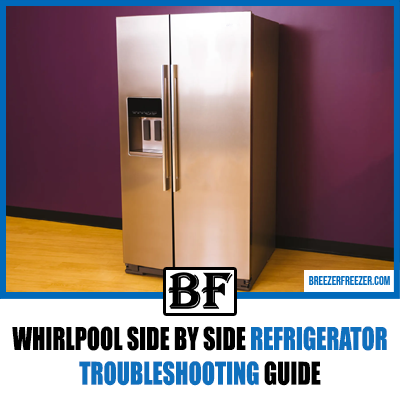
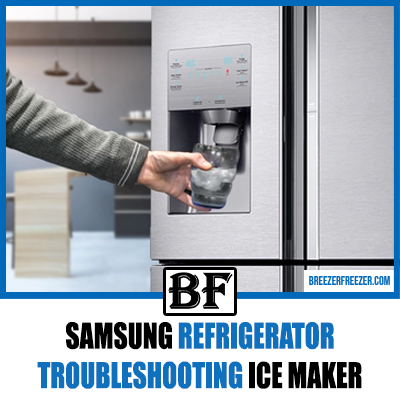
![How Long Is Cake Good For in The Fridge? [Quick Answer!]](https://breezerfreezer.com/wp-content/uploads/2023/10/How-Long-Is-Cake-Good-For-in-The-Fridge.png)
